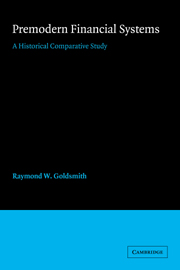Book contents
- Frontmatter
- Contents
- List of tables
- Preface
- 1 Introduction
- 2 The financial systems of the ancient Near East
- 3 The financial system of Periclean Athens
- 4 The financial system of Augustan Rome
- 5 The financial system of the early Abbasid caliphate
- 6 The financial system of the Ottoman Empire at the death of Suleiman I
- 7 The financial system of Mughal India at the death of Akbar
- 8 The financial system of early Tokugawa Japan
- 9 The financial system of Medici Florence
- 10 The financial system of Elizabethan England
- 11 The financial system of the United Provinces at the Peace of Münster
- 12 Similarities and differences
- Notes
- Bibliography
- Index
- Frontmatter
- Contents
- List of tables
- Preface
- 1 Introduction
- 2 The financial systems of the ancient Near East
- 3 The financial system of Periclean Athens
- 4 The financial system of Augustan Rome
- 5 The financial system of the early Abbasid caliphate
- 6 The financial system of the Ottoman Empire at the death of Suleiman I
- 7 The financial system of Mughal India at the death of Akbar
- 8 The financial system of early Tokugawa Japan
- 9 The financial system of Medici Florence
- 10 The financial system of Elizabethan England
- 11 The financial system of the United Provinces at the Peace of Münster
- 12 Similarities and differences
- Notes
- Bibliography
- Index
Summary
A financial system is the connected universe of financial instruments, financial institutions, and financial markets operating in a given place at a given time, that is, it is the financial superstructure of the economy. Financial systems of different places or dates therefore differ from or resemble each other in the number, character, method of operation, and size of their instruments, institutions, and markets. It is the purpose of this study to describe the financial systems of a number of representative premodern economies and to relate them to the underlying structure of income and wealth. Before proceeding to this task it is necessary to provide a very brief discussion of the purpose and a description of the terms and measures used, the selection of the systems covered, and the sources and limitations of the data, leaving the last chapter to point out the similarities and differences among the systems studied.
In the premodern period financial instruments were almost limited to evidences of debt, that is, to claims and liabilities, which were characterized primarily by their origin, maturity, conditions of service (interest), and repayment, specific security or lack of it, absence or mode of transferability, and issuer. Probably the oldest form of financial instruments were trade and consumer credit usually of a duration of less than one year.
- Type
- Chapter
- Information
- Premodern Financial SystemsA Historical Comparative Study, pp. 1 - 9Publisher: Cambridge University PressPrint publication year: 1987

